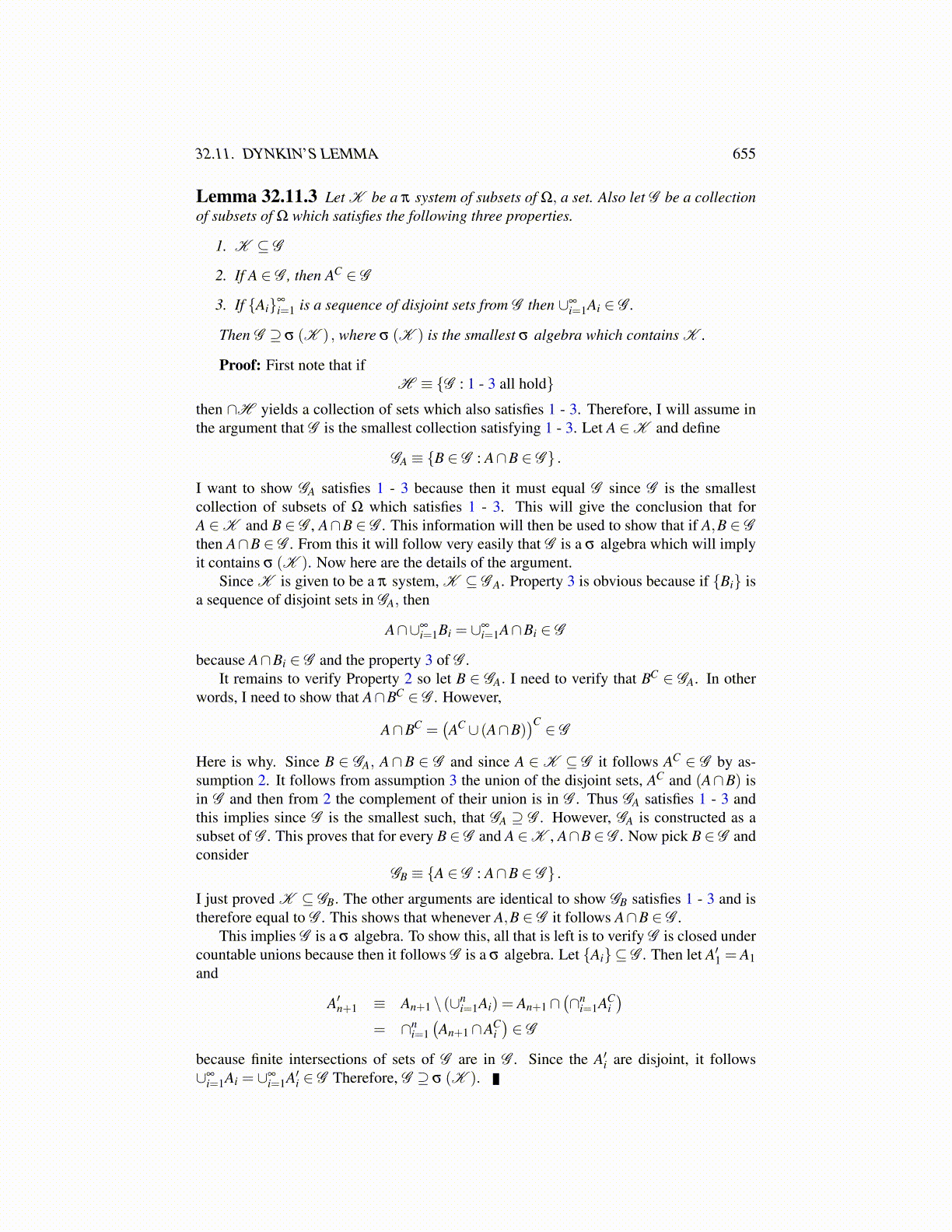
32.13. EXERCISES 655
is closed with respect to complements and countable disjoint unions as in Dynkin’slemma, and contains /0 and Ω. If H ⊆ G is any set whose elements are subsets ofP (Ω) which satisfies property P, then ∩H also satisfies property P. Thus there is asmallest subset of G satisfying P.
2. Show B (Rp) = σ (P) where P consists of the half open rectangles which are ofthe form ∏
pi=1[ai,bi). Recall B (Rp) is the smallest σ algebra containing the open
sets.
3. Show that f : (Ω,F )→ R is measurable if and only if f−1 (open) ∈ F . Show thatif E is any set in B (R) , then f−1 (E) ∈ F . Thus, inverse images of Borel setsare measurable. Next consider f : (Ω,F )→ R being measurable and g : R→ R isBorel measurable, meaning that g−1 (open) ∈ B (R). Explain why g ◦ f is measur-able. Hint: You know that (g◦ f )−1 (U) = f−1
(g−1 (U)
). For your information,
it does not work the other way around. That is, measurable composed with Borelmeasurable is not necessarily measurable. In fact examples exist which show that ifg is measurable and f is continuous, then g◦ f may fail to be measurable. However,these things are not for this book.
4. Let Xi ≡ Rni and let X = ∏ni=1 Xi and let the distance between two points in X be
given by∥x−y∥ ≡ max{∥xi −yi∥ , i = 1,2, · · · ,n}
Show that any set of the form
n
∏i=1
Ei, Ei ∈ B (Xi)
is a Borel set. That is, the product of Borel sets is Borel. Hint: You might considerthe continuous functions π i : ∏
nj=1 X j → Xi which are the projection maps. Thus
π i (x)≡ xi. Then π−1i (Ei) would have to be Borel measurable whenever Ei ∈B (Xi).
Explain why. You know π i is continuous. Why would π−1i (Borel) be a Borel set?
Then you might argue that ∏ni=1 Ei = ∩n
i=1π−1i (Ei) . Set the text for a special case
that Xi = R in the next chapter.
5. You have two finite measures defined on B (X) µ,ν . Suppose these are equal onevery open set. Show that these must be equal on every Borel set. Hint: You shoulduse Dynkin’s lemma to show this very easily.
6. Let µ (E) = 1 if 0 ∈ E and µ (E) = 0 if 0 /∈ E. Show this is a measure on P (R).
7. Give an example of a measure µ and a measure space and a decreasing sequence ofmeasurable sets {Ei} such that limn→∞ µ (En) ̸= µ (∩∞
i=1Ei).
8. If you have a finite measure µ on B (Rp), and if E ∈ B (Rp) , show that there existsets F,G such that G is a countable intersection of open sets, called a Gδ set and F acountable union of closed sets, called an Fσ set, such that F ⊆E ⊆G and µ (G\F) =0. Hint: Show first for G open. Then you might try to use Dynkin’s lemma to extendto Borel sets. Recall that B (Rp) = σ (K ) where K consists of the open sets. Inthe first part, you might want to use Proposition 15.6.4 to produce an increasingsequence closed sets whose union is the open set G.